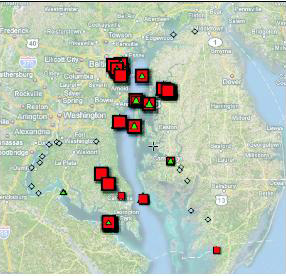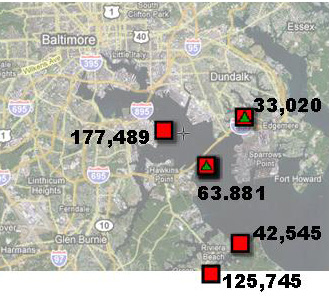Annapolis, MD (May 21, 2009) - Chesapeake Bay scientists at the Maryland Department of Natural Resources (DNR) are observing extensive algal blooms in the Maryland portion of the Bay cause by high concentrations of the algae Prorocentrum minimum. These blooms are referred to as mahogany tides due to the fact that they cause the water to have a brownish to mahogany hue, a result of the reddish pigments within the algal cell. This is analogous to leaves on plants varying in color based on the pigments they contain. The large bloom this year is likely due to increased runoff of nutrients and decreased main bay salinities as a result of the wet spring.
This algal species, generally believed to be non-toxic, is common in the Bay and routinely occurs in abundance every spring. Indirect effects of blooms often lead to low dissolved oxygen that can affect a broad array of living resources. For example, several fish and shellfish kills were evident in the bloom region under similar bloom conditions in 2000. In addition, bay grass die-backs in the Middle Chesapeake Bay area were also attributed to Mahogany tides that occurred in 2000. The blooms reduced water clarity in these areas, blocking sunlight from reaching underwater plants during the critical spring growth period.
Bloom levels (>3,000 cells/ml) have been found from the Western Shore in the Patapsco and Severn Rivers (177,483 and 91,694 cells/ml on 5/20, respectfully) and Rock Creek (125,745 cells/ml on 5/20) across the Bay to the Chester River (59,817 cells/ml on 5/5) and south to an area from West River (154,686 cells/ml on 5/13) across to the mouth of Eastern Bay (9,088 cells/ml on 5/11). There have also been bloom levels detected in the middle Patuxent River (10,281 cells/ml on 5/8 down to 146 cells/ml on 5/20) and the mouth of the Lower Potomac River (29,464 cells/ml on 5/11). Concentrations comparable to those currently being seen have occasionally occurred in past years. Blooms have decreased light penetration in some areas including the main bay (bay bridge down to Kent Point) and the Patapsco River (figure 2) and are expected to reduce oxygen after the bloom dies off.
 |

|
Figure 1: Locations of blooms of Prorocentrum minimum in a) the Chesapeake Bay, MD and b) the Patapsco River over the past two weeks. Data courtesy of MD Department of Natural Resources, Morgan State University, and the MD Department of the Environment.
2009 Water Clarity (Secchi Depth)
Chesapeake Bay Mainstem / Kent Point (SW) (CB4.1C)

Figure 2: Decreased water clarity in the Main Bay decreases the amount of light available for seagrass growth (data from MD Department of Natural Resources https://eyesonthebay.dnr.maryland.gov/eyesonthebay/index.cfm ).
Researchers from the University of Maryland, Center for Environmental Science are studying the bloom this year, as they did in 1998 and 2000 when significant blooms occurred, to determine the factors that stimulate blooms, as well as the impact of these blooms on the ecosystem. In addition, scientists and managers are working to develop bloom forecast capabilities. Some researchers have reported on the toxicity of Prorocentrum to marine life in the laboratory, but no toxic effects have been observed in the Chesapeake Bay and its tributaries over the many years during which these blooms have been observed.
Everyone needs to do their part to reduce nutrients flowing into the Chesapeake Bay. There are many ways that YOU can help. Bay scientists will continue to monitor the algal bloom situation. As in past years, the current bloom should subside in most locations by the end of May. To track current and past harmful algae blooms in Maryland visit https://eyesonthebay.dnr.maryland.gov/hab/HAB_maps.cfm.
The Maryland Department of the Environment (MDE) fish kill investigation and DNR teams will continue to track the situation and will respond to any reports of fish kills related to the die-off of this bloom. Reports of fish kills or algal blooms should be made to 410-974-3238 on weekdays and 1-877-224-7229 on evenings and weekends.
|



